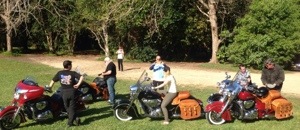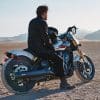A day riding the Indian Chief Vintage with brown leather saddle and bags leaves you feeling a bit like an urban cowboy. It’s a good feeling thanks to a bike that exudes character, style, performance and quality.
We’ve just returned from a ride through the Tweed hinterland on the new Indian Chief Classic, Vintage and Chieftain. It has been perfect weather with perfect roads, great company and (near) perfect bikes.
While I will leave a full review for a time when I get one of the scarce bikes for a longer test, given the amount of interested in these bikes, I thought I’d summarise my impressions of the Chief under the headings “The Good”, “The Bad” and “The Ugly” just to keep the cowboy imagery going.
THE GOOD
There is a lot to like about the Indian Chief.
It looks impressive from a distance and is just as impressive when you get up close and notice the attention to detail such as the Indian head stamped on the side of the triple clamp and on the foot brake reservoir, plus the acres of chrome.
The heart of the bike is a powerful 111cc Thunder Stroke engine which is quiet and very responsive. It feels every bit as strong as the new Twin-Cooled Harley 103 Twin Cam with a love of free revving. However, it has more roll-on acceleration, probably because the bike is geared lower.
It will do 90 degree turns in third or fourth yet lazily amble along the highway at 100km/h in six at 2250rpm. Then, just roll on the throttle and you are doing 120 in about three seconds. Harleys require you to drop a cog or even two for the same response.
The front brakes are strong with plenty of feel and the ABS works a treat.
The cruise also works very well, even though it’s on the wrong switchblock – it should be on the left.
Gears are positive and not too clunky, even though they are handling a whole lot of torque.
The genuine plush leather seats not only look great but are comfortable for long days in the saddle and the pillion perch and reach to the pegs is generous.
Controls are easy to use and the tank-mounted instruments are clear.
I love the powered windscreen on the Chieftain. In the top position there is no buffeting at all.
However, it’s the naked look and feel that I really love, looking out over that massive chromed headlight and wide, wide bars.
The bars afford you a good grip on the bike and help keep things stable at high speed.
I experienced no high-speed weave from the fork-mounted fairing on the Chieftain.
If you don’t like the wide bars, you can get accessory bars and the best news is that they come with the same discrete internal wiring as the standard bars. Very neat.
THE BAD
While the engine is quiet, the screens on the Chieftain and Vintage echo the whine from the transmission back at you and, on occasion, some valve noise.
The bars are perhaps a bit too wide and tend to flex a bit. Over some rough patches of road, they vibrated quite a lot.
In fact, I had to adjust the mirrors a couple of times because the vibration had made them move.
However, these bikes are all pre-validation units, so there are some niggling problems such as mirrors that are not fitted tight enough, floating floorboards that are too floaty and seats where the foam is a little lumpy. All these issues will be sorted it on the production bikes, according to Indian country manager Peter Harvey.
The instruments panel on the Chieftain is difficult to see because the plastic cover reflects back at you.
While the headers and the lower engine don’t give out a lot of heat, the rear valve cover is so close to your crotch it can’t not cause a problem. While it’s nice to be able to look down and see the “knucklehead” valve cover between the seat and the tank, the trade-off is the heat issue. I found it quite hot until you got above 60km/h.
The Chieftain has a steeper steering head angle and therefore shorter wheelbase for more direct steering, but it makes the cockpit a little bit cramped for tall people.
The Vintage and Classic have better accommodation for tall people, yet with the narrow seat front, short people will still be able to get their feet firmly on the ground.
While the front brakes are very effective, the rear brakes tend to lock up too quickly at high speed and at low speed, the ABS sounds very abrupt and clunky.
Because of legal issues, you can’t trail brake the rear through a corner and accelerate at the same time as the engine cuts out.
This is due to an issue in the USA where Toyota Camry floor mats would wedge between the brake and accelerator and when you hit the brake, it would also hit the throttle. So the USA has now mandated that the throttle has to shut down when the brakes are on.
None of the stereo units on the bikes worked particularly well. One had a speaker down, another buzzed and the third wouldn’t work at all. But remember these are pre-production bikes. However, from what I heard, they don’t sound as clear as the new Harley Touring sounds systems, even though they are more powerful.
THE UGLY
Well, apart from the tassles on the Vintage, there really isn’t anything ugly about these bikes at all.
And even the seat tassles can be removed as they are only attached by Velcro. However, you will have to use scissors to get rid of the tassles on the bags.
If you like tassles, then you’re in luck as you can get accessory tassles for the fenders and floorboards!
THE VERDICT
Having just returned for the USA riding the new Harley Touring range, this Indian Chief ride offers the perfect opportunity to compare.
While the Classic competes with a Softail Deluxe and the Vintage with a Heritage Softail, these bikes handle much better; more like the Road King.
My pick is the Vintage in traditional blue … But I’d cut off the tassles.
Read more about the Indian Chief here or type “Indian Chief” in the search panel at the top right of the page.



